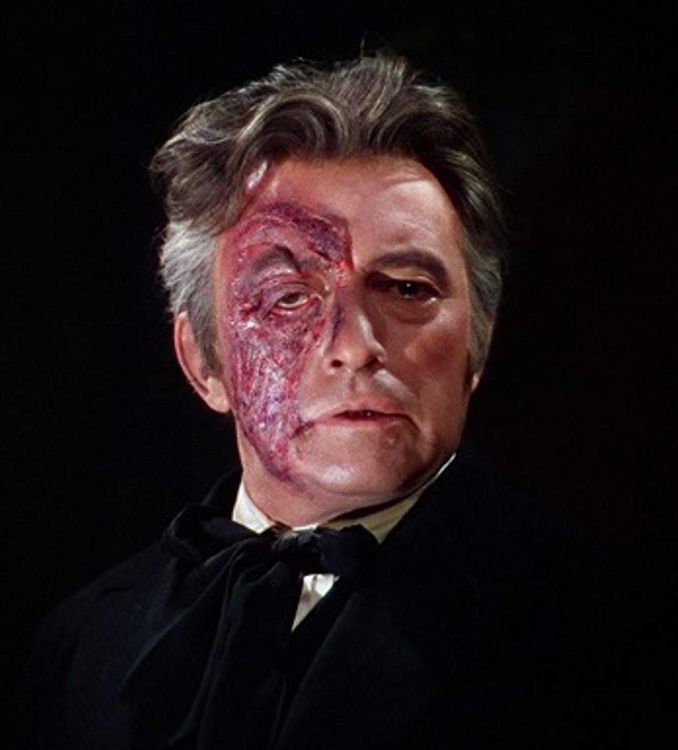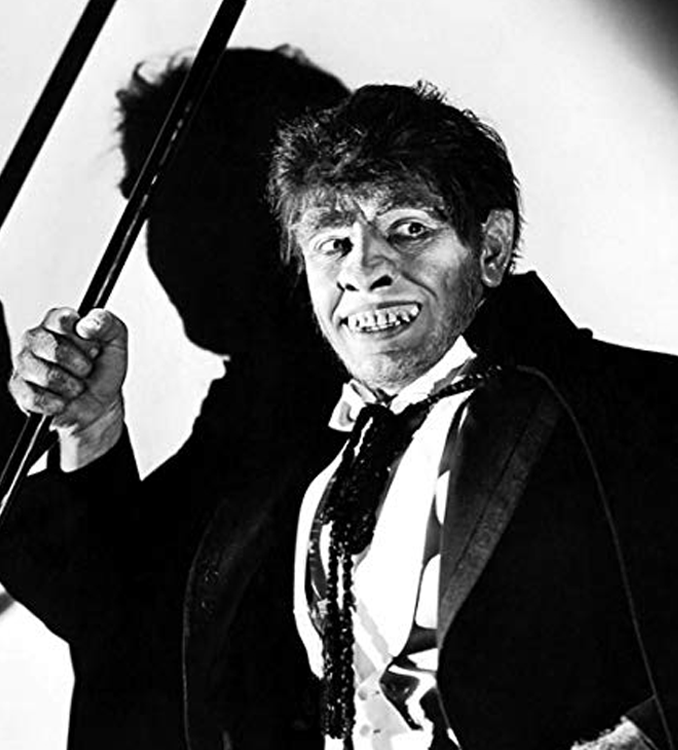
If you’re on this site right now, I’m going to assume you’re familiar with Universal’s indisputably iconic Dracula (1931). Béla Lugosi. Tod Browning. Dwight Frye. That guy with the cockney accent who keeps calling Frye a “loony.” All your favorite friends.
What you may not be familiar with are the two slightly more forgettable sequels produced in the 12 years that followed. While 1936’s Dracula’s Daughter is fine, sure, we’re here to talk about Son of Dracula. Released 75 years ago today, on November 5, 1943, Son of Dracula is not without its quirks. Most notably, the film features the Wolf Man himself, Lon Chaney, Jr., in the role of Count Alucard. Here’s a little insider information for you: Alucard spelled backwards is “Dracula.” Feel free to take a few minutes if needed.


Just two years after The Wolf Man (1941)—the role that defined his career—Chaney took his first and last stab at playing a vampire. Looking and sounding a bit different than Béla’s Count, Lon’s portrayal of Alucard has been the subject of some debate and ridicule over the years. Not necessarily famous for his range, Chaney dropped The Count’s instantly recognizable accent altogether and presented us with a much different take on the legendary vampire.
Whether you’re into it or over it, Chaney took a risk when he stepped into that already famous role, and in honor of Lon’s valiant attempt to fill Béla’s undead shoes, let’s take a look at four other times a Universal horror icon took on someone else’s monster.
Vincent Price as The Invisible Man in The Invisible Man Returns (1940)
Made famous by Claude Rains in The Invisible Man (1933)
When Frankenstein director James Whale signed on to direct The Invisible Man in the early 1930s, Claude Rains was his first choice to play the bandaged lunatic. Rains’ distinct voice and maniacal laugh proved to be a perfect match for the largely faceless role, and The Invisible Man—Rains’ first appearance in an American film—launched an impressive and varied career that would span three decades.
So varied, in fact, that Rains never once returned to the character of Dr. Jack Griffin, and in 1940, when it came time to milk that invisible cash cow, Universal was forced to find someone else to inject with that sweet, sweet Monocane. Enter Vincent Price.


With just three other films on his resume, Price’s take on the Invisible Man was his first journey into the horror genre, and it would be another 13 years before his portrayal of Professor Henry Jarrod in 1953’s House of Wax revitalized his career and cemented him as one of horror’s leading men.
Price’s unmistakable voice proved to be a good replacement for Rains, and The Invisible Man Returns was a commercial and critical success. Unlike Rains, who was too busy being recognized with Academy Award nominations (ick!), Price returned to the role in 1948 for a brief cameo in Abbott and Costello Meet Frankenstein.
Béla Lugosi as Frankenstein’s Monster in Frankenstein Meets The Wolf Man (1943)
Made famous by Boris Karloff in Frankenstein (1931)
After the success of Dracula in 1931, Universal naturally looked to Béla Lugosi when production started on Frankenstein later that same year. Lugosi, believing he was above the non-speaking, heavily made-up character, famously turned down the role and simultaneously set a new benchmark for “worst possible career move.”
As we all know, the part went to Boris Karloff, and Frankenstein would go on to be accepted as one of the greatest films of all time. I mean, it has a 100% rating on Rotten Tomatoes, so it’s at least as good as Toy Story.
While Karloff would reprise his role as the Monster twice more for Bride of Frankenstein in 1935 and Son of Frankenstein in 1939, Lugosi finally got his time to shine in 1943 for Universal’s first “Monster Rally” film, Frankenstein Meets The Wolf Man. “Shine” is probably an overstatement, as Lugosi (who was then 60 years old) suffered exhaustion during filming and was largely replaced with stand-ins.


Whether intentional or not, Lugosi still managed to leave a lasting impact on how we remember Frankenstein’s Monster. The film’s original script included dialogue explaining that the Monster was blinded during a brain transplant in 1942’s The Ghost of Frankenstein—a film which actually features our old pal Lon Chaney, Jr. as the Monster.
While the blindness explains Lugosi’s groping, stiff-armed walk, test audiences found the thickly-accented Hungarian Monster hilarious, and the dialogue was scrapped entirely leaving the now-iconic “Frankenstein walk” completely unexplained.
Claude Rains as The Phantom in Phantom of the Opera (1943)
Made famous by Lon Chaney in The Phantom of the Opera (1925)
Sixteen years before Lon Chaney, Jr. was bitten by that werewolf, his father, Lon Chaney, made horror history with the 1925 silent adaptation of Gaston Leroux’s The Phantom of the Opera. Considered to be the dawn of Universal horror along with 1923’s The Hunchback of Notre Dame (also starring Chaney), Phantom has since been deemed “culturally significant” by the Library of Congress and preserved in the United States National Film Registry.
As major film studios aren’t often known for their restraint, Universal would be involved with the production of several more Phantom adaptations throughout the years, including the relatively divisive 1943 film starring Claude Rains.


Shot on the same elaborate soundstage built for Chaney’s film, the similarities between the two adaptations mostly begin and end with the Opera House set. Even with its diluted storyline, 1943’s Phantom of the Opera holds the honor of being the only Universal horror film to win an Oscar. So that’s something.
Rains has since been praised for his take on the mysterious Erique Claudin, but as The New Yorker’s David Lardner noted in his review of the film, “The old version had Lon Chaney, who scared you plenty, and the new one has Claude Rains, who somehow doesn’t.”
Boris Karloff as Dr. Jekyll in Abbott and Costello Meet Dr. Jekyll and Mr. Hyde (1953)
Made famous by Fredric March in Dr. Jekyll and Mr. Hyde (1931)
While Wikipedia lists an astonishing five film adaptations of Robert Louis Stevenson’s 1886 novella Strange Case of Dr. Jekyll and Mr. Hyde before 1930, we’re going to be considering Fredric March’s renowned 1931 take on the character to be the most iconic. Though John Barrymore’s portrayal of the possessed doctor in 1920 was met with critical acclaim, March’s performance earned him his first Academy Award for Best Actor in a Leading Role.
Notable within this list for being the only non-Universal release, Dr. Jekyll and Mr. Hyde was a box office success in line with Universal’s Dracula and Frankenstein from the same year.
In 1953, Universal released Abbott and Costello Meet Dr. Jekyll and Mr. Hyde. Starring Boris Karloff, the film was the third entry in the comedy duo’s monster series behind 1948’s Meet Frankenstein—which featured Glenn Strange in the role of the Monster—and 1951’s Meet the Invisible Man.


Not particularly well-loved, Meet Dr. Jekyll and Mr. Hyde came just four years after Bud, Lou, and Boris collaborated on the deceivingly titled Abbott and Costello Meet the Killer, Boris Karloff in 1949. Karloff’s performance as Dr. Jekyll received a mixed response and was generally derided by critics for its complete lack of struggle between good and evil. You know, the theme of the entire story.
As if that wasn’t enough, contrary to the credits, Karloff never even played Mr. Hyde in the film. Once the detailed transformation sequences were complete, stuntman Eddie Parker stepped in (in an uncredited role) to bring Mr. Hyde to life. Not cool, Boris.
Are you a fan of any of these “cover performances?” Did we miss your favorite? Let us know in the comments below.




Be the first to comment